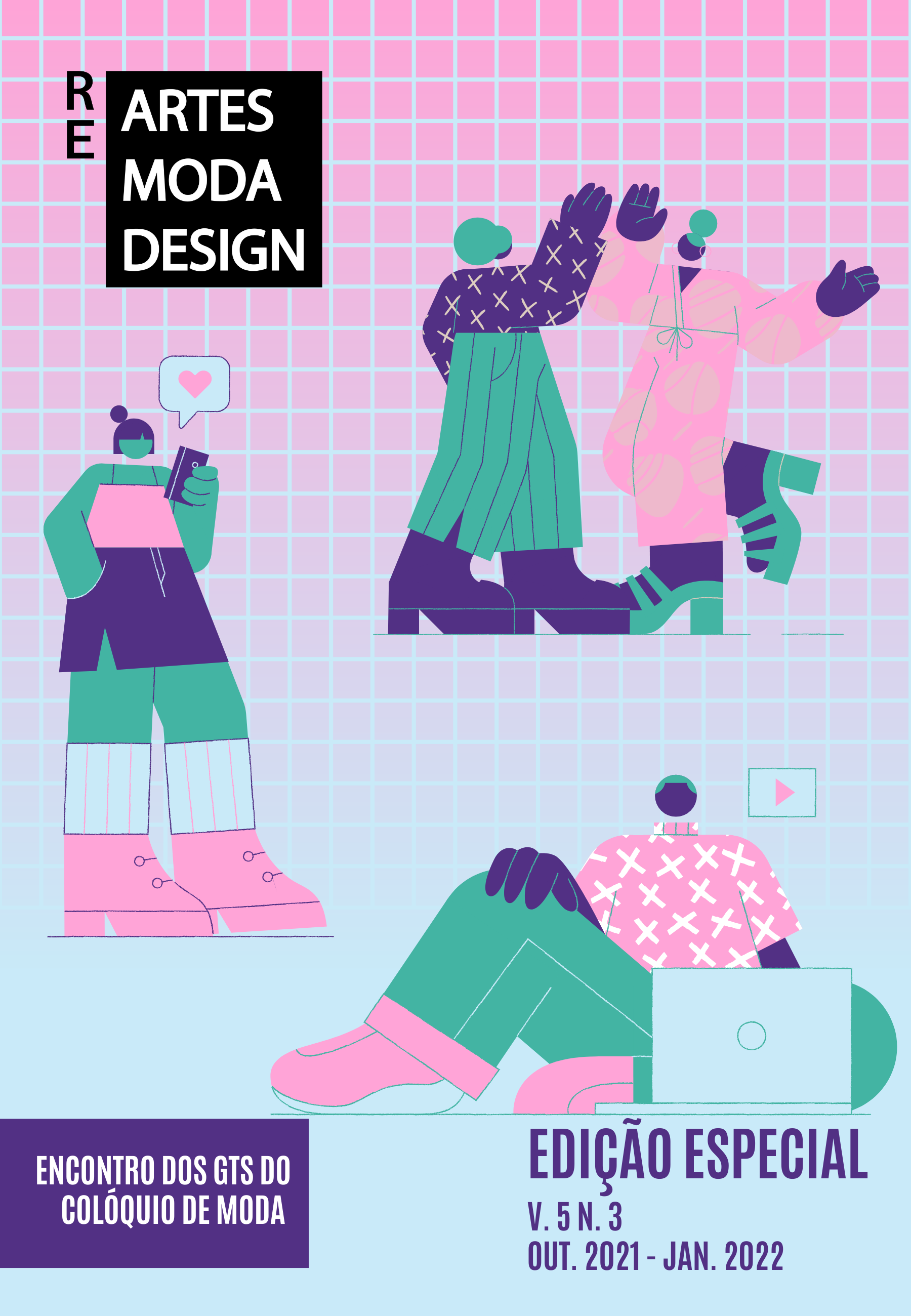Fashion and social distinction signs in the life of a uruguayan artist
DOI:
https://doi.org/10.5965/25944630532021128%20Keywords:
Artist, fashion, pressAbstract
The article analyzes a set of images, from photographs to photographic reproductions in
the Uruguayan and Brazilian journals such as Anales: Revista Mensual Ilustrada, Mundo
Uruguayo, O Cruzeiro, and O Jornal. These images are indications of the artistic trajectory
of the Uruguayan Raquel Aliseris Bernadá [de Labaure-Casaravilla] (1923-1986) from
a photo in which she appears with the laureate work “Patos Pekineses” from the Salón
Nacional in 1938, a porteño exhibition, her presence in European museums where she
made copies of renowned works, attending parties until getting married in Montevideo. The
images reveal this artist’s trajectory with signs of social distinction and identify the fashion
and the appearance culture. The turning point is the wedding. The bride is represented in
the Montevideo newspapers within the tradition with touches of modernity, with a satin dress,
veil, wreath and original bouquet. The research showed an artist committed to her art and
dressed with sobriety and elegance in places of artistic sociability. On the other hand, she
is seen by the Rioplatense and Brazilian press as a socialite, with clothes denoting social
distinction and according to fashion trends.
Downloads
References
ALCOTT, Louisa May. Mulherzinhas. Apresentação, tradução e notas Bruno Gambarotto. 1 ed. Rio de Janeiro: Zahar, 2019.
ANCHIETA, Isabelle. Imagens da Mulher no Ocidente Moderno 3: Stars de Hollywood. São Paulo: Edusp, 2019.
BARBILLON, Claire et alii. Parent-elles, compagne de, fille de, soeur de...: Les femmes artistes au risque de la parentèle. Poitiers: Actes de Colloque/Université de Poitiers, 2017. Acesso ao site: awarewomenartists.com, em 11/02/21.
BOUCHER, François. História do Vestuário no Ocidente: das origens aos nossos dias. São Paulo: Cosac Naify, 2012.
BROQUETAS, Magdalena. Fotografia e identidad. La revista “Mundo uruguayo” en la conformación de un nuevo imaginario nacional en el Uruguay del Centenario. In: Arteologie: Recherche sur les arts, le patrimoine et la littérature de l’Amérique Latine. Paris: CNRS/Maison Amérique Latine/l’École des Hautes Etudes en Sciences Sociales/Open Edition Journals, n. 7, 2015. Site: https://doi.org/10.4000/arteologie.1060 acesso em 28/09/2020.
CAVALCANTI, Ana. Apresentação. O artista em representação : imagens de artistas através da História da Arte. Modos, v. 3, 2019.
CUNHA, Maria Teresa Santos. Armadilhas da sedução: Os romances de M. Delly. Belo Horizonte: Autêntica, 1999.
JINCHUK, Natalia. Que sepa coser, que sepa bordar. In: miradacouture.com. acesso em 03/10/20.
MACHADO JÚNIOR, Cláudio de Sá. Imagens da Sociedade Porto-Alegrense: vida pública e comportamento nas fotografias da Revista do Globo (década de 1920). São Leopoldo: Oikos Editora; Porto Alegre: PMPA, 2009.
MILLER, Daniel. Trecos, troços e coisas: estudos antropológicos sobre a cultura material. Rio de Janeiro: Zahar, 2013.
MELLO E SOUZA, Gilda. O Espírito das Roupas: A Moda no século XIX. São Paulo: Companhia das Letras; Rio de Janeiro: Ouro sobre Azul, 2019.
OLIVEIRA, Claudia de. Moda, Arte e Sociedade: O pioneirismo da maison Canadá-de-Luxe e a emergência da indústria fashion nacional nos anos 1950. (revistas.udesc.br) acesso em 30/09/2020.
SANT’ANNA, Mara Rúbia. Elegância, Beleza e Poder: Na sociedade de moda dos anos 50 e 60. São Paulo: Estação das Letras e Cores, 2014.
SILVA. Camila Borges da. A indumentária no museu: algumas considerações sobre memória e patrimônio. In: SILVA, Camila Borges da; MONTELEONE, Joana; DEBOM, Paulo (Orgs.). A História na Moda, A Moda na História. São Paulo: Alameda, 2019. p. 303-330.
SIMIONI, Ana Paula Cavalcanti. Profissão Artista: Pintoras e Escultoras Acadêmicas Brasileiras. São Paulo: Edusp, 2008.
Downloads
Published
How to Cite
Issue
Section
License
Copyright (c) 2021 Cristiane Garcia Teixeira, Maria de Fátima Fontes Piazza

This work is licensed under a Creative Commons Attribution 4.0 International License.
- Authors retain copyright and grant the journal the right of first publication, with work simultaneously licensed under the Creative Commons Attribution 4.0 International License, which allows for:
1. Share — copy and redistribute the material in any medium or format for any purpose, even commercially.
2. Adapt — remix, transform, and build upon the material for any purpose, even commercially.
The licensor cannot revoke these freedoms as long as you follow the license terms.Under the following terms:
1. Attribution — You must give appropriate credit, provide a link to the license, and indicate if changes were made. You may do so in any reasonable manner, but not in any way that suggests the licensor endorses you or your use.
2. No additional restrictions — You may not apply legal terms or technological measures that legally restrict others from doing anything the license permits. -
Plagiarism, in all its forms, constitutes unethical publication behavior and is unacceptable. This magazine uses iThenticate similarity control software.






